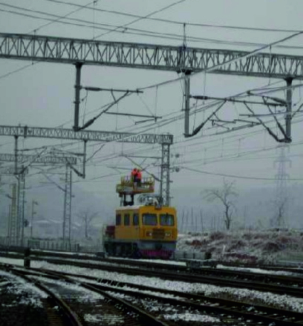Powerlines, overhead lines, pantograph
Power lines and overhead lines over the railway track, pantograph.

The overhead lines are stationary and the pantograph is the structure on the roof of the train, that connects the power line with the train.
These parts are vulnerable to cold weather, because they are out in the open with very little protection against the weather. The pantograph can accumulate snow easier than the power line alone because the pantograph is a more solid structure. Pantograph is also cooled at high speed because of the air flow around it works like strong wind.
Power lines also become stiffer at low temperatures, and accreted ice can cause arc formation. A stiffer line is easier to break, and arcing can cause problems with electricity conduction. While snow is not directly a problem for the powerlines, as the snow accretion is minimal on the line itself, snow can still cause for example tree branches to fall on the powerline. However, the vicinity of the track is usually kept free of trees partly for this reason.
More on this topic: Icing on powerlines
References
- ↑ He-yun, L. et al. (2012). Icing and Anti-Icing of Railway Contact Wires. Reliability and Safety in Railway, InTech.
- ↑ Niklas Kandelin: Icing Factors Affecting Railway Traffic Master of Science Thesis Tampere University Master’s Degree Programme, Materials Science October 2021
- ↑ Kloow, L. (2011). High-speed train operation in winter climate. KTH Railway Group Publication 1106.
- ↑ Lei Guo et al. (2016) ‘Thermal field analysis of icing contact line under the effect of pantograph-catenary system arc’, in 2016 IEEE International Conference on Power System Technology (POWERCON). [Online]. 2016 IEEE. pp. 1–6.
- ↑ Farzaneh, M. (2008) Atmospheric Icing of Power Networks. 1st ed. 2008. [Online]. Dordrecht: Springer Netherlands.
- ↑ Akagawa, S. et al. (2017) Frost Heaving in Ballast Railway Tracks. Procedia engineering. [Online] 189547–553.